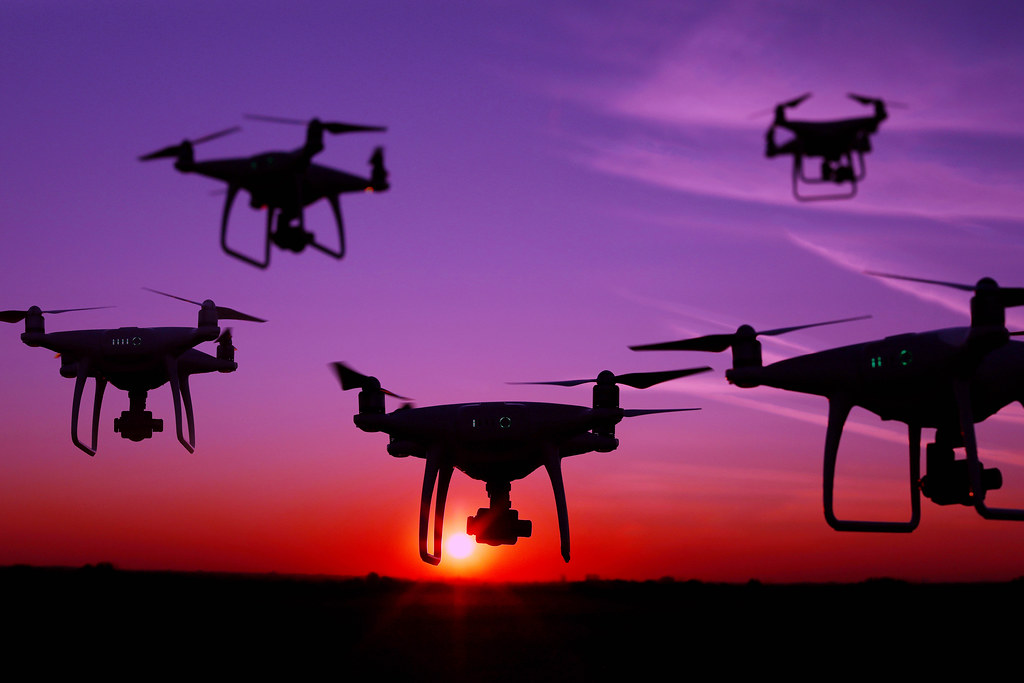 CC Image courtesy of Marco Verch Professional Photographer on Flickr
CC Image courtesy of Marco Verch Professional Photographer on Flickr
How Ukrainian Air Defense Strategy is Adapting to More Drone Attacks
On June 6th, 2023, the Kakhovka dam collapsed, flooding Ukrainian cities and adding to the humanitarian disaster of this war. This wanton destruction of civilian infrastructure is emblematic of Russia’s frustration with its lack of progress against the Ukrainian military, and is often carried out by Russian drones racing through the skies in search of anything to destroy. To respond to the growing presence of aerial drones, Ukraine has upgraded its defense strategy. Ukrainian forces have used new technology coupled with artificial intelligence (AI) to better respond to the swarm threat posed by Russia. The rapid incorporation of Unmanned Aerial Vehicles (UAVs) and AI on the battlefield has motivated changes in air defense strategies, as well as raised questions of what the future of warfare will hold.
Drones have become a critical part of the Ukraine-Russia war with both countries using advanced semi-autonomous vehicles for surveillance and offensive capability. Russian forces have used Iranian Shahed-136 drones, a type of loitering munition commonly referred to as a kamikaze drone since it executes an attack by physically colliding with the target and exploding. Smaller Orlan-10 drones that reach high altitudes, carry cameras and smaller bombs aboard, and locate targets to guide forces to them, have also been used. Through drone swarms, when large quantities of kamikaze drones are deployed, Russian forces have challenged Ukrainian air defenses by conducting surveillance, attacking Ukrainian targets, and damaging energy infrastructure.
Ukrainian forces have also deployed a diverse range of drones. The Turkish Bayraktar TB2 drone has primarily been used to destroy Russian equipment. U.S.-supplied switchblade drones can eliminate a variety of targets ranging from small targets six miles away to tanks twenty-five miles away. Ukraine has also used Phoenix Ghost Drones with advanced optical systems to destroy targets. In addition to military-designed drones, both countries have utilized commercial DJI drones for intelligence, surveillance, and reconnaissance.
With the presence of technology growing in the war, Ukrainian air defense forces have strengthened their response with electronic warfare strategies, notably drone detection and mitigation techniques. Detection often involves tracking radio frequency, heat signatures, and acoustics of drone motors. Whereas, mitigation’s focus is to target and intercept drones with tactics such as jamming, which disrupt communication between the drone and remote operator. Ukrainian forces have also used navigation spoofing, by creating artificial no-fly zones that have successfully confused Russian drones and led them to fall. Though this method is not new, it has proven to be extremely effective in taking down Russian-operated off-the-shelf drones.
Ukraine has also enhanced its mobile air defense units. Ukrainian forces have new searchlight technology to locate and destroy drones during the night. As part of this strategy, civilians have access to apps to help track drone sightings and paths.
Over the course of the war, Ukraine has also acquired new AI-based drones to intercept and attack Russian drones. With the abundance of kamikaze drones, Ukraine has received drone interceptors that collide with Russian drones prior to reaching their destination. AI-based interceptors include the U.S.-developed Anvil System which identifies threats, deploys interceptors, and destroys the incoming drone regardless of its size. Ukraine has also used the MARSS interceptor, which is a high-speed quad-engine drone that uses “smart vision”-equipped interceptors to locate targets, and then utilizes AI-powered dogfighting abilities to ram the target to destroy it. Finally, Ukraine has smaller interceptor devices that are manufactured locally, such as the Fowler. These interceptor devices allow Ukraine to respond to Russian swarms in conjunction with older low-tech standard military vehicles and defense systems, such as the Gepard, to destroy Russian swarms.
Given the wide-range of targets, Ukraine also relies on defense systems such as the U.S. Patriot, and the Soviet-era Osa and Buk. The Patriot assists Ukraine in achieving a greater range and capability of air defense. Similarly, with the high altitude the Russian Orlan-10 can reach, the Osa and Buk surface-to-air systems are often used. However, these systems were not designed to destroy inexpensive drones and thus, when used, deplete valuable Ukrainian ammunition.
Drones are an instrumental aspect of the Ukraine-Russia war enabling significant damage, reconnaissance, and distraction at low cost, thereby requiring robust defense responses. The future of warfare is indeed at an inflection point, in which the international system must consider how to balance technological advancement with ethics. In a time where drones and AI-based systems are being used to target civilians and outrunning international legislation, the proliferation and degree to which autonomous systems are deployed warrants international attention.
Photo Licensed under Creative Commons Attribution 4.0 International (CC by 4.0).





